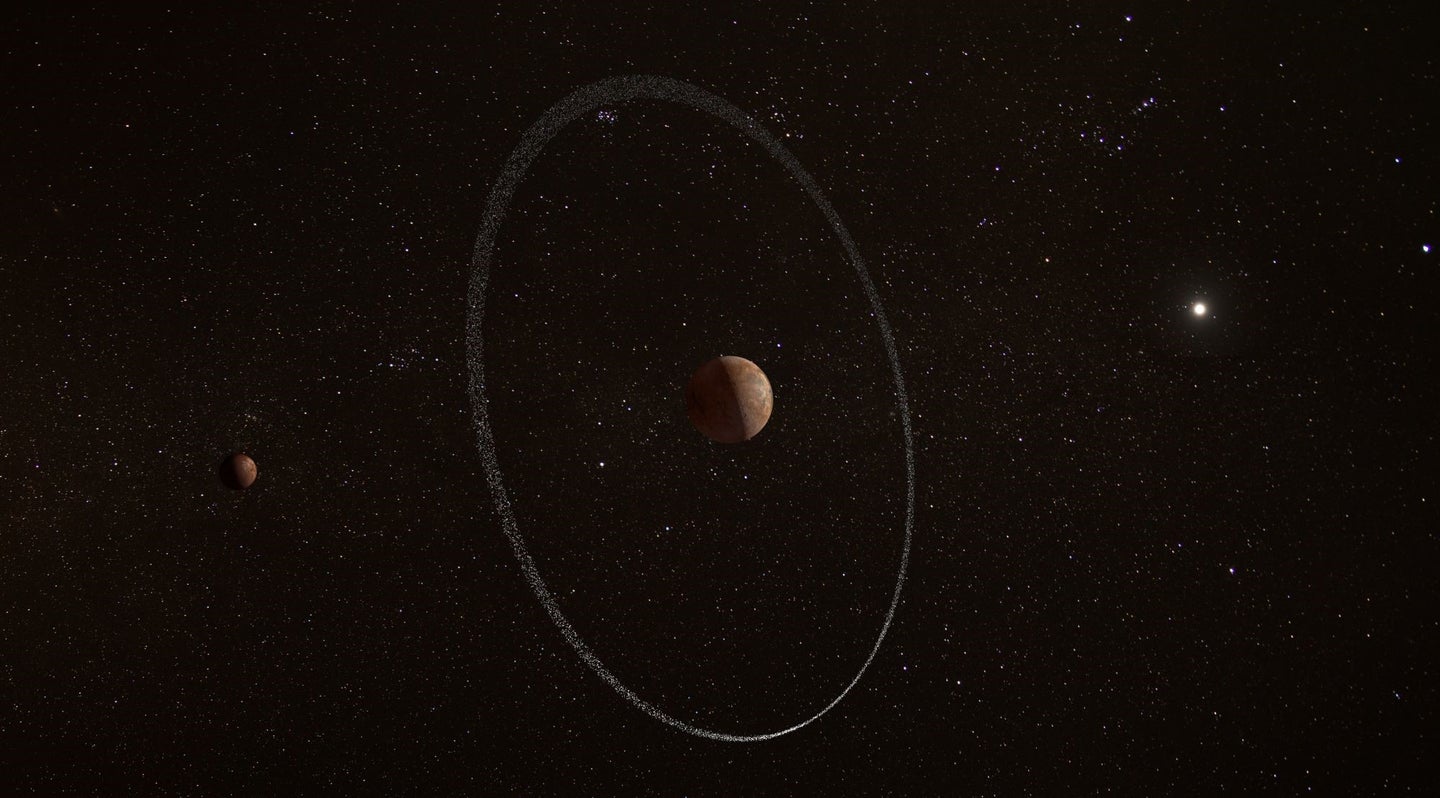
Scientists have discovered a ring system around a small object beyond the orbit of Neptune, a surprising discovery in itself. But the observation comes with a mystery to boot: How is this ring system possible when, by all accounts, it shouldn’t exist?
The ring in question orbits Quaoar, a small dwarf planet that lies more than 6.5 trillion miles from the sun—roughly 44 times the distance between Earth and our star. Detecting a dense ring around such a small, distant object was no easy feat, but what really stunned the international group of researchers who made the discovery was this: The ring appears to orbit Quaoar too far away. At that distance, the dwarf planet’s gravity should be too weak to tug on the individual particles in the ring to keep them from forming into a moon or moons.
“This ring is not where we would expect it to be,” Bruno Morgado, an astronomer at Federal University of Rio de Janeiro and the lead author of a new paper published in the journal Nature, tells Popular Science in an email. “This may change what we know about how rings were formed.”
As University of Idaho physicist Matthew Hedman put it in a commentary published in the same edition of Nature, this places Quaoar’s ring system “at odds with our current understanding of how such rings are maintained.”
[Related: This weird dwarf planet at the edge of our solar system has a new origin story]
Rings are made of chunks of dust, ice, and other materials, orbiting in a disk around a planetary body. For many years, the large, beautiful rings of Saturn, first observed and characterized in the 1600s, were the only ones known to astronomers. It wasn’t until Voyager 1 passed by Jupiter in 1979 that it was determined the largest planet in our solar system also possessed a ring system, albeit less striking than Saturn’s. It’s now known that all of the solar system’s gas giants possess ring systems. Rings have also been found among a few distant bodies, such as Humea, which like Quaoar—and Eris and Pluto, for that matter—are considered trans-Neptunian objects.
All of these ring systems but Quaoar’s have one thing in common—the rings orbit within what is known as the Roche limit of their planetary body. This is the distance beyond which the gravitational pull of the planetary body can no longer keep the ring material from forming into larger chunks, which would eventually coalesce into a moon. Inside the limit, the varying strength of gravity on ring particles at different altitudes would keep them spread out.
But Quaoar’s Roche limit is about 1,100 miles from its center. The dense ring orbits at 2,500 miles from the dwarf planet’s center. “This means that the mutual gravitational attraction of chunks of water ice [in the ring] should easily overwhelm the variations in Quaoar’s gravitational pull,” Hedman writes. “We therefore need some other explanation for why this material hasn’t aggregated into a moon.”
Morgado and his colleagues consider several explanations. One is that the ring material is relatively new, resulting from an impact with a moon orbiting Quaoar, and simply hasn’t had time to re-coalesce. But this is unlikely, they write in the paper, as their computer models suggest this material would condense into a new moon within a matter of decades.
It’s also possible the ring material itself is bouncier than models predict. If so, each chunk would be more likely to bounce off another than to stick, even without the tug of Quaoar’s gravity to keep them apart.
[Related: Jupiter formed dinky little rings, and there’s a convincing explanation why]
Another possibility is that the ring system is regularly perturbed by the gravity of some other object, such as Quaoar’s moon, Weywot, or another, yet-to-be-discovered moon. It is, after all, very difficult to study trans-Neptunian objects. This ring discovery was only made possible because the research group brought a wide array of cutting-edge telescopes to bear on Quaoar. That includes the European Space Agency’s ESA’s CHaracterising ExOPlanet Satellite (Cheops) mission, a space telescope that was able to detect Quaoar’s ring by watching for changes in the intensity of background starlight as it monitored the dwarf planet.
“Now we need to keep observing Quaoar, to better determine this ring, and also see if (and how) it changes with time,” Morgado says. “Also more dynamical studies and simulations need to be done to see under which circumstances a ring is stable so far outside the Roche limit.”
The results of further study could force astronomers to change their understanding of the Roche limit. It’s also possible Quaoar is an exception to the rule—but one that enables a deeper understanding of the orbital dynamics of other large structures, Morgado says, “even other objects such as exoplanets, galaxies.”
The post Distant dwarf planet Quaoar shouldn’t have a ring, but it does appeared first on Popular Science.
Articles may contain affiliate links which enable us to share in the revenue of any purchases made.
from Popular Science https://ift.tt/2zwHEoA



0 Comments